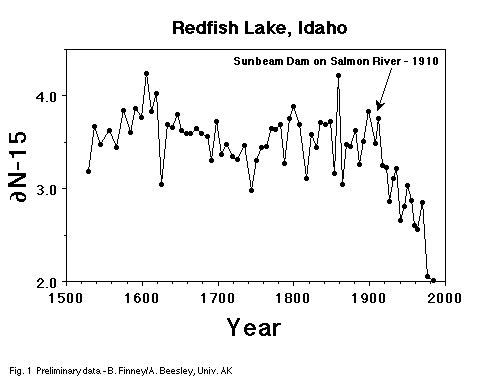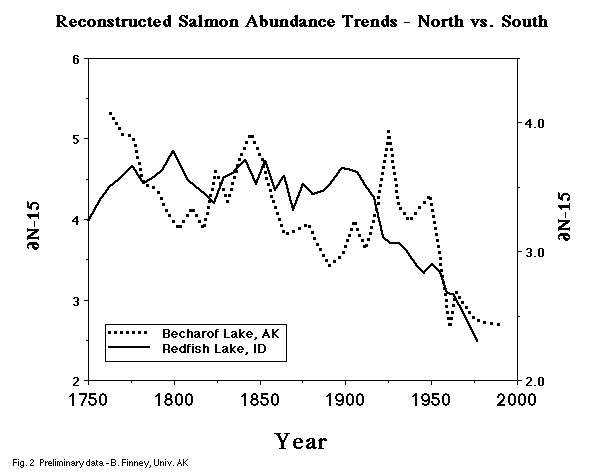Cores were in hand for this project from the Alaska sites, and fieldwork was carried out during the summer of 1998 for sites in the Pacific Northwest. A total of 14 Columbia River sockeye systems (present and extinct) were successfully cored, and preliminary work has been conducted on the cores to select sites for further study. In addition, through collaboration with DFO, we are working on cores from Shuswap Lake, Fraser River, BC. Salmon reconstructions for the Alaska sites are nearly complete, and preliminary data is available for several sites in the Pacific Northwest/BC.
Figure 1 shows preliminary N-15 data for Redfish Lake, Idaho. The N-15 data is interpreted as a proxy for sockeye salmon escapement, with higher N-15 values indicating higher levels of marine-derived nutrients in freshwater ecosystems resulting from higher escapement (Finney, 1998). The most conspicuous feature is the sharp decline following construction of the Sunbeam dam on the Salmon River downstream of the lake in 1910, and the subsequent slide towards extinction. Prior to this event, N-15 variability may be related to climate/ocean influences. A core GLOBEC hypothesis is that "Production regimes in the Coastal Gulf of Alaska (GOA) and California Current (CC) systems covary, and are coupled through atmospheric and ocean forcing". A preliminary evaluation of this hypothesis is presented in Figure 2, which compares N-15 records from Redfish Lake (CC) to Becharof Lake, Bristol Bay, AK (GOA). The 20th century portion of both records is strongly impacted by human influence. As discussed, the Sunbeam dam and subsequent changes downstream on the Columbia River had a large impact on Redfish Lake sockeye. The decline in Becharof Lake around 1950 probably reflects the shift to a cooler, less productive regime for GOA salmon. Since that time the fishery has been managed for a constant escapement goal. Thus the sediments do not record the large increase in salmon production in this system following the regime shift in the late 1970s. Interestingly, the records from about 1750 to the early 1900s suggest opposite trends during some periods, consistent with the hypothesis of out of phase behavior. Work is in progress to relate these records to paleoclimatic changes, derived from tree ring data.



Finney, B.P. (1998). Long-term variability in Alaskan sockeye salmon abundance determined by analysis of sediment cores. North Pacific Anadromous Fish Commission Bulletin 1: 388-395.